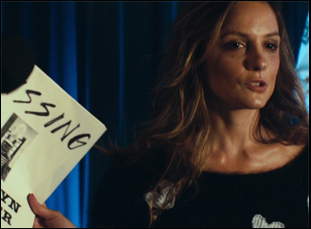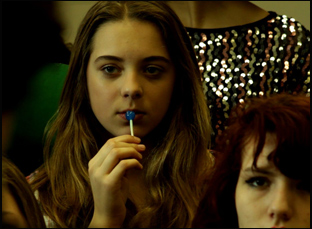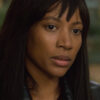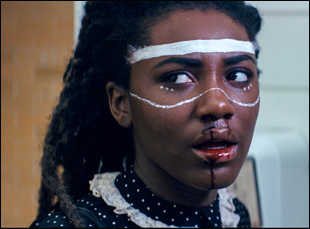For the past decade, Jennifer Reeder has been leaving the breadcrumbs for what would become “Knives and Skin,” a bewitching mystery that actually becomes more intriguing rather than less once you have all the clues. Having created short films that would establish her distinctive style often summoning the soulfulness of teenage girls who find themselves unable to express themselves fully in their Midwest environs, Reeder can be bold when her young protagonists fear the consequences in a male-dominated world, recasting pop ballads in personal terms through hauntingly intimate arrangements, bringing out vibrant colors in neighborhoods that have changed little in decor (and decorum) since the 1950s, except to fade in luster, and creating a layered experience through the editing in which the weight of the world can feel if it’s bearing down on her characters with the way images and scenes can pile on one another, offering transcendence as you gradually see them rise to the top.
Although Reeder is the first to cop to the influence of David Lynch’s “Twin Peaks” in crafting an elusive narrative around a missing high schooler named Carolyn Harper (Raven Whitley), it’s as evident that she has a distinctive voice all her own as it is what happened to the marching band member, opening “Knives and Skin” with Carolyn’s demise. Still, only the boy she made plans to meet up with knows of where the body is after a romantic encounter gone awry and Carolyn’s disappearance unlocks a wave of anxiety in her community even if it’s mostly limited to whispers when she looms larger when thought of as a victim than she was alive and well, largely unnoticed and unappreciated. This unsettling realization, unspoken yet felt most deeply by the women in town, turns the once comfortable traditions of Americana that gives the town its identity, so intertwined with domestic roles that are so heavily defined for men and women, into awkward routines that no longer make sense.
Still, there is considerable elegance in how Reeder delivers a similar jolt for audiences in subverting the reliably heartwarming coming-of-age genre by ditching the rose-colored glasses of nostalgia to look at cultural attitudes and cycles of behavior that have made each future generation held up by standards that feel they should be further and further in the past and while the director shook up the romcom with her vivacious feature debut “Signature Move,” a lesbian love story set in the world of lucha libre wrestling, “Knives and Skin” feels as bleeding edge as its title implies, cutting a path through the festival circuit in recent months since taking the Berlin Film Festival by storm. While the film was at Tribeca en route to premieres at the Overlook Film Festival in New Orleans, Oak Cliff Film Fest in Texas and Fantasia Film Fest in Montreal, Reeder spoke about rewarding longtime fans with her latest film and all the work that went into winning over new ones with this sensational provocation.
In the U.S., short films just don’t have the robust kind of life outside of film festivals that feature-length films do, so I’ve always been thinking I need to make some longer films, but of course longer films also are much more time-consuming and they cost more money. There’s also lots of ideas that just shouldn’t be a long film, so I’ve been making these shorts and I’ve been developing my voice and telling these very particular stories about very particular people in a very particular way utilizing my influences from my art school days. And since the shorts were so enthusiastically embraced by audiences both in and outside of the U.S., I thought there’s a bigger story in here that involves some of these narratives [in the shorts] — these kind of nuanced exchanges between awkward teenagers and even more awkward adults.
I actually had planned to make “Knives and Skin” the summer that we shot “Signature Move,” but “Signature Move” was on a different timeline, so I put “Knives and Skin” aside and of course I didn’t write “Signature Move” — Fawzia [Mirza] and Lisa [Donato] wrote it — but it was still delightful to work on that film and I feel like I brought a lot of my own voice to that. And taking that time away really actually help me overhaul the script for “Knives and Skin,” thinking about how this longer film would be different from the short and would also be a stand out in a sea of feature-length films. So I totally overhauled the script and we shot it over 25 days last summer.
Did making “Signature Move” help you figure out how to even structure a feature shoot?
100% On the one hand, making a feature is not that dissimilar than making a short. There’s more people. It’s more expensive. You’re shooting for more days. But you still want to concentrate and keep the narrative together and you want to foster and maintain a healthy, creative set. But you’re shooting it totally out of order, so you really have to to maintain not just a physical continuity in terms of what the actors are wearing and what the room looks like, but a tonal continuity. And when you’re doing a short over two or three days, that’s much easier to do because you just shot the scene that gets sutured to this other scene [from] the day before whereas we were shooting some scenes that are meant to take place in the same sort of time period or shooting the beginning of one scene and the end of that same scene maybe two weeks apart, just because of actors’ schedules or weather or the location. That’s the thing that kept me up at night, sitting with the material, looking at what we were shooting in the next couple of days, remembering what we had shot the days before, looking at stills, re-reading the script, and really just really trying to keep in mind that we were making a film that ended up to be an hour and 50 minutes. Keeping all of that material tonally in the same register was a challenge.
Is it hard to establish the proper tone when the teens are playing adults and the adults are kids to some degree?
Yes and no. We cast the entire film out of Chicago [because] there’s such a remarkable pool of talented actors here, so all those young people are have lots of film and television experience but more so stage experience, so they actually all came to the project with poise and professionalism. They had all read the script ahead of time and it was interesting the first couple of times that I would work with a new actor on set, their instinct often in terms of interpreting the script was to inject some of the dialogue with a kind of teen angst melodrama. And I kept saying, “It needs to be more deadpan. If we go deadpan with some of this dialogue, then it makes you guys seem much more seasoned like you know exactly how this story is going to play out. There’s nothing more boring in the world right now than your life, which is just in turmoil,” and then it was the adults who I directed to be a little more a little more animated or have more of the melodrama. So we flipped it like that and then we would do a scene where maybe the adult was in a scene with the teenager and once those people got that chemistry between themselves not as the characters, but as the actors, it was really fun to just watch those whole scenes unravel.

I had long conversations with my longtime DP Christopher Rejano about the color. We wanted the whole film to just hover slightly above reality, just vibrating with these violets, magentas and cyans. The whole thing gets bathed in a feminine sensibility in the most rote sense — if we essentialize pink and purple as being feminine colors — but at the same time, I wanted the whole film to be wrapped in this vibrating magenta with these pops of violet, gold and cyan, so we were looking at examples of Robby Mueller’s work in “Paris, Texas” or Argento’s “Suspiria” or even Italian horror films that are related to Argento’s films that use color garishly. We were looking at the photography of Gregory Crewdson, [where] there’s often a bold light source, but it’s unclear where the light’s coming from, and Todd Hido, who shoots a lot of exteriors of houses that have very unnatural lighting/color with also light sources that are coming from a mysterious point of view, and also a painter like Jenny Saville, specifically in terms of how to deal with Carolyn Harper’s body.
It was 100% the case that my actors would be outside during the day eating lunch, chit-chatting and we would be like, “Okay, bring the actors to set” and they would walk into a room that was dark purple and it really brought them into the wormhole of this small town and this kind of psychosis. And then it was sweltering. We shot in July, so there was also something about the color vibrating and the heat of the space. I was not in all trying to traumatize my actors in real-life. [laughs] I dearly love and protect my actors, but I definitely think that that the that the lighting and the general atmosphere that we created through the through the lighting helped bring out some very particular performances.
You really have to create an environment from scratch – every element of the football game, from the costumes to the cheering crowds for instance, I imagine.
The football game was actually a blast to shoot. That was very specifically constructed and choreographed. There’s other there’s other moments on set that can be a little looser and you can play with the camera angle and you can play with where the blocking is, but with that in particular, we had to match up footage that we shot on a night when there was no football game in a completely empty stadium with a bunch of our own extras with when we went back once the football season has begun [and] we shot pickups and B-roll during an actual game. We sutured those two things together to make it seem like all this confrontation and these conversations are happening while this big active high school football game is going on. We matched uniforms. We shot at angles so that we could avoid obviously the actual players’ faces or anything that had any of the school logos on them and we tried to match some of our extras with the actual people at the game. It was nerve-racking because it was a very particular puzzle, but once we got it to work, it was so satisfying.
That blend of reality and fiction seems to be nicely metaphorical for the film you made.
For sure. And even when I was in high school, [when] I was still just a very goth punk misfit girl, I never missed a football game. It had nothing to do with football. It was simply a social event in the town, so I would hide away in different corners of the stadium with my friends and we would talk and hang out and make fun of other people and let them make fun of us as cliques will do. But I love the spectacle of the game. It’s very theatrical. Those fields, if they belong to a certain kind of school and a certain socio-economic region, are maintained and once the sun goes down and those giant lights go up, it’s really a spectacle that reminds me of my background as a dancer, reminds me of theater and really reminds me of cinema. So I always knew even when the producers at some point said, like “Oh gosh, a football game? That’s going to be a lot of work.” And I said, “I’m standing firm with this football game. It has to be in there.” But we tried to make the football game itself seem a little surreal. We took we took as many liberties as we could to make it seem like the most untypical football game you’ve ever seen.

I knew I wanted to put songs in this film, both in a diegetic way, but also in ways that were more surprising. For instance, there’s a moment in the middle [with] all the characters singing together in a fantastical kind of musical number. So working with a company called Groove Garden that does music licensing, I had a whole initial set of songs plugged into the script. A lot of them that never changed. We always had [The Go-Gos’] “Our Lips are Sealed,” [Cyndi Lauper’s] “Girls Just Want to Have Fun,” and “Blue Monday” by New Order, and there were other songs that we tried to get the right to that were either way too expensive or we literally couldn’t get ahold of the people who own the publishing rights, but once we had all of the songs finalized, I worked with Jenne Lennon, who I’ve worked with previously to recompose these arrangements, to make these kind of lullaby / lamentation versions of these very catchy pop songs.
Then we spent a day of rehearsals teaching all those songs to all of those people and then when they got to set, we pre-recorded three of the songs, so people were simply singing back to the playback — for instance, the bigger choir scenes, people were singing to playback because it was just been too hard to get everybody in sync all the same time. But then the other songs, people could hear [the song] in a a very small earbud and they were there were singing to a sync track that Jenne made. So it’s a multi-layered process figuring out how we were going to get those songs physically into the film, whether it was singing to play back on set or doing a live singing to play back. We did a version of Culture Club’s “Do You Really Want To Hurt Me” that it breaks my heart, but it was a scene that got cut out, so there was actually one more song in the film which is a really lovely heartbreaking rendition of that maybe will make it onto the DVD extras. But the rest of them stayed and I feel really happy with how they have all how they all live in the film.
The film’s editing style is also wonderful in how layered it feels, as if one image or scene can stack on top of the next. How did that come into play?
I worked with Michael Olenick, the same editor that I’ve worked for the for the past 14 years and it wasn’t dissimilar than what we’ve done with the shorts. For better for worse, I am a sucker for those long cross dissolves, I love the superimposition, and I love being able to put two characters in the same psychological space, but also in the same cinematic space, especially if they really aren’t. Adjusting the framing of some of those scenes when you’re in post-production so maybe it looks like a hand in one scene brushes across the face of the person in another, we really create this third level of meaning in those superimpositions and a third level of relationships among characters and among images. Thankfully my editor is totally into that — and there’s plenty of editors who aren’t and want straight cuts and that’s it. We definitely took some liberties with how we dealt with some transitions, but I stand firmly and and boldly by how they work and the film is really meant to invite you into a very particular world, so at some point the idea that transitions have to reflect the reality of space and time was just totally out the window.
And I’m not an idiot. I know what my other short films have done and there are people who just don’t get it. They don’t like them and there are people who are the super fans, so I feel like I’ve made this film for them. Even in Berlin, there were people who saw this film who hasn’t seen the shorts and have become super fans, which is so rewarding and validating to me. I made the film that I set out to make and my producers, who are amazing, gave me full creative freedom, which I felt was really important. So this is a love letter to my super fans, but it’s also a film that I think people who haven’t seen the shorts, but who are ready to watch a very special, very particular kind of American indie will really enjoy this film. Just buckle up because it’s an interesting ride bathed in magenta.
“Knives and Skin” will screen at the Overlook Film Festival in New Orleans at the Cinebarre Canal Place on June 1st at 2:45 pm and June 2nd at 12:15 pm, the Oak Cliff Film Festival on June 7th at the Bishop Arts Theater at 9:15 pm, and Frameline in San Francisco on June 24th at 9:15 pm at the Roxie Theatre and June 25th at 7 pm at the Landmark Shattuck.





